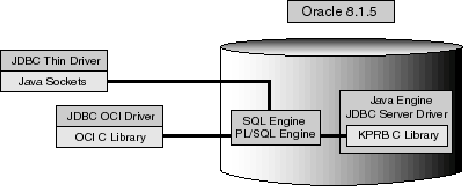Release 8.1.5
A64685-01
Library |
Product |
Contents |
Index |
| Oracle8i JDBC Developer's Guide and Reference Release 8.1.5 A64685-01 |
|
This section has the following subsections:
Figure 1-1 illustrates the driver-database architecture for the JDBC Thin, OCI, and Server drivers.

The Oracle JDBC Thin driver is a Type IV driver that is targeted to applet developers. This driver is written in 100% Pure Java and complies with the JDBC 1.22 standard.
For communicating with the database, the driver includes an equivalent implementation of Oracle's TTC presentation protocol and Net8 session protocol in Java. Both of these protocols are lightweight implementation versions of their counterparts on the server. The Net8 protocol runs over TCP/IP only. To use this driver, it is not necessary to install any Oracle-specific software on the client.
The HTTP protocol is stateless but the Thin driver is not. The initial HTTP request to download the applet and the Thin driver is stateless. Once the Thin driver establishes the database connection, the communication between the browser and the database is stateful and in a two-tier configuration.
The JDBC OCI driver is a Type II driver that is targeted to client-server Java applications programmers and Java-based middle-tier developers. The JDBC OCI driver converts JDBC invocations to calls to the Oracle Call Interface (OCI). These calls are then sent over Net8 to the Oracle database server.
The JDBC OCI driver is written in a combination of Java and C because it must make calls to the OCI libraries. The driver requires the presence of the OCI libraries, Net8, CORE libraries, and other necessary files on each client machine or middle-tier application server on which it is installed.
The JDBC Server driver allows Java programs that use the Oracle 8.1.5 Java Virtual Machine (VM) and run inside the database to communicate with the SQL engine. The Server driver, the Java VM, the database, the KPRB (server-side) C library, and the SQL engine all run within the same address space. There are no network round-trips involved. The programs access the SQL engine by using function calls.